Luke Skywalker
Super Moderator
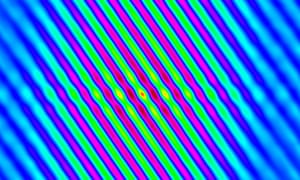
Autocorrelation of a trimmed surface Photograph: Sam Ashworth/2019 EPSRC Photography Competition
- People and Skills category, first prize and overall winner: Syrian refugee at Azraw refugee camp by Dr Dima Albadra, University of Bath
As part of a participatory design workshop, refugees in Azraq and Zaatari refugee camps in Jordan used virtual reality to offer feedback and adapt suggested shelter typologies. Participatory design is a two-way process allowing refugees to be part of the research team. Image taken on 30 October 2018
Photograph: Dr Dima Albadra/2019 EPSRC Photography Competition
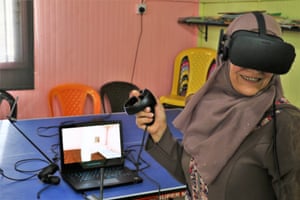
- People and Skills category, second prize: A happy shelter designer by Dr Francis Moran, University of Bath
This is SheltAir, an elastic grid shell structure designed and developed by Gregory Quinn at the Berlin University of the Arts. Working with the University of Bath’s Healthy Housing for the Displaced project, a 10-metre diameter solution was developed and assembled at the Building Research Park, Swindon, for a year-long trial. Made of glass fibre rods secured to a perimeter steel ring beam, the shelters can provide shelter to three families or be used as a service building
Photograph: Dr Francis Moran/2019 EPSRC Photography Competition
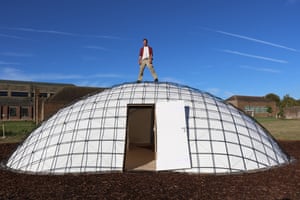
- People and Skills category, third prize: Keep on spinning by Ben Stone, Loughborough University
The image shows the process of carefully fine-tuning the athlete, hand-bike and their interactions. In a complex sporting environment, optimal performance in hand-cycling depends on factors ranging from physical capacity, propulsion technique, skill, training effort and technology. The Peter Harrison Centre for Disability Sport at Loughborough University is regarded as world-leading in producing disability sport research
Photograph: Ben Stone/2019 EPSRC Photography Competition
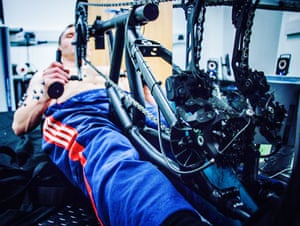
- Equipment and Facilities category, first prize: Citizen science abroad by Peter Pedersen, University of Cambridge
Taking the sensor hub that our group developed abroad to the Alps. This was part of a citizen science initiative called Cambike Sensor, measuring the air pollution that cyclists are subjected to around Cambridge. The image was taken in the Alps, 1 September 2018, with an Android phone
Photograph: Mr Peter Pedersen/2019 EPSRC Photography Competition
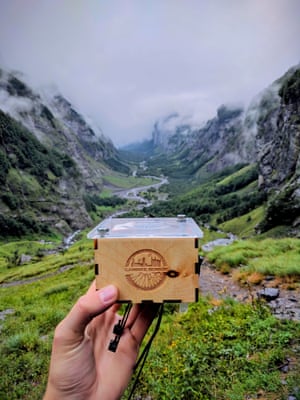
- Equipment and Facilities category, second prize: Vacuum apparatus for single molecule trapping by Dr Ana Rakonjac, Durham University
A view down the length of a vacuum chamber that will hold single trapped diatomic molecules assembled from individual atoms. Four electrodes traverse the length of the chamber, which will provide an electric field to orient the molecules. These molecules will be used to test out quantum logic operations for future quantum computers. The image was taken using a Canon PowerShot S95 on 19 December 2018
Photograph: Dr Ana Rakonjac/2019 EPSRC Photography Competition
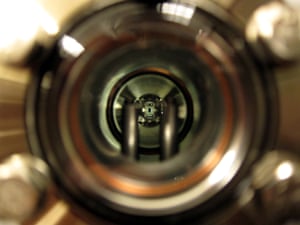
- Equipment and Facilities category, third prize:One hundred tiny painters by Dr Edmund Hunt, University of Bristol
In the future, large groups of nanoscale robots could work on tasks such as delivering drugs to tumours. Ants lay pheromones on the ground to communicate indirectly. One behaviour is laying territory-marking pheromone so that other ants know the area has already been explored. Tiny, light-sensitive robots could be manipulated under the microscope in such a way in future nanomedicine. Work at Bristol Robotics Laboratory with Sabine Hauert and Jerry Wright
Photograph: Dr Edmund Hunt/2019 EPSRC Photography Competition
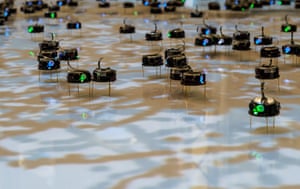
- Weird and Wonderful category, first prize: Fatberg crystals by Natalia Jawiarczyk, Cranfield University
This photo presents the effect of fats, oils and greases (Fog) deposits fractionation using organic solvent. The residues on the filter paper represents non-lipid constituents of fatberg. Deposition and accumulation of Fog in sewers are causing increasing problems in the water sector. The aim of the study is to establish how deposits form in the sewer network and how they can be degraded and inhibited with bioaugmentation products and give better insight into fatberg formation
Photograph: Natalia Jawiarczyk/2019 EPSRC Photography Competition
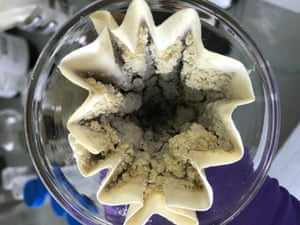
- Weird and Wonderful category, second prize: Crystal Summit by Alexandru Moldovan, University of Leeds
Photo shows crystals grown from a crushed-up tablet dissolved in methylated spirits, taken using polarised light to give the different colours. Moldovan’s work looks at predicting and measuring the sticking between particles within drug formulations, in the hope of one day predicting their impact on the patient, allowing for tailored design and manufacturing for individuals. Image taken at home using Frankenstein-ed microscope
Photograph: Alex Moldovan/2019 EPSRC Photography Competition
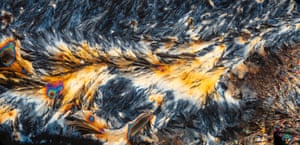
- Weird and Wonderful category, third prize: Ultra-realistic synthetic 3D models by Dr Marco Palombo, University College London
The cerebellum is a major feature of the hindbrain of all vertebrates, and plays a pivotal role in movement-related functions in humans. It comprises several types of neurons. Here we used our novel computational model to control such complexity and ultimately provide a tool to decode it
Photograph: Dr Marco Palombo/2019 EPSRC Photography Competition
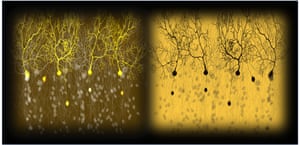
- Eureka and Discovery category, first prize:The mysterious and colourful second crystal by Finlay Walton, University of Glasgow
The moment that a mysterious, colourful and disordered new crystal form was discovered (left), alongside the known crystal (right). Previously only shadows of this triphenyl phosphite crystal have been hinted at from X-rays and melting points. The image was taken using a polarisation microscope, where only crystals that twist light are visible
Photograph: Finlay Walton/2019 EPSRC Photography Competition
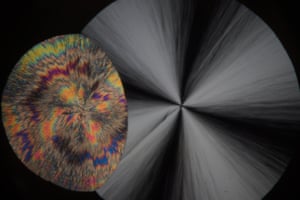
- Eureka and Discovery category, second prize:Lovastatin crystals by Dr Wei Li, Loughborough University
Lovastatin is widely used for the treatment of hypercholesterolemia, but the crystalline form of elongated needles is notorious for its poor manufacturability of the final drug product. The aspect ratio of these needle-shaped crystals can be modified by a polymer additive, polypropylene glycol (PPG), which acts as growth blocking agent on selected crystal faces. Further shape modifications may be obtained using temperature cycles of crystal growth and dissolution
Photograph: Dr Wei Li/2019 EPSRC Photography Competition
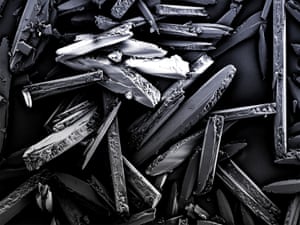
- Eureka and Discovery category, third prize: Autocorrelation of a trimmed surface by Sam Ashworth, University of Sheffield
This image shows a representation of an edge-milled carbon fibre reinforced polymer. The colours of the image show the preferential direction of a periodically iterated surface structure which have been applied through a statistical process known as autocorrelation. The image was taken using an Alicona InfiniteFocus SL optical microscope at 10x magnification at the Advanced Manufacturing Research Centre, 2018
Photograph: Sam Ashworth/2019 EPSRC Photography Competition
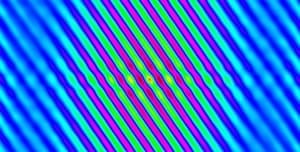
- Innovation category, first prize:Wonderlandballs in small world by Dr Qin Hu, University of Nottingham
This image shows various polymeric micro-sized balls designed by Joseph White and fabricated by Dr Qin Hufabricated by two-photon lithography-based 3D printing technology. The diameter of each ball is 40μm, roughly less than half of the diameter of human hair. The smallest feature size shown here is roughly 100nm. The image was captured using Hitachi desktop Scanning Electron Microscopy (SEM) on a tilted stage, with a magnification of 800 times
Photograph: Dr Qin Hu/2019 EPSRC Photography Competition
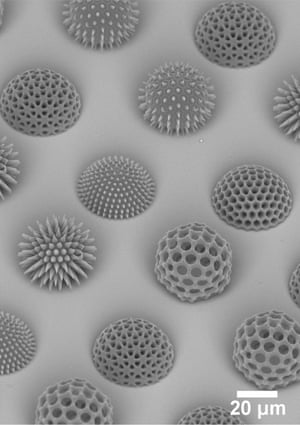
- Innovation category, second prize: Spatially structured laser beam by Dr Aidan Arnold, University of Strathclyde
Laguerre-Gauss beams and more generally the orbital angular momentum of light (OAM) provide valuable research tools. High-efficiency frequency conversion of OAM in the two pump beams determines the total shared by generated light fields – but not the distribution between them. This investigation has looked at the OAM spread of generated light modes as a function of pump OAM. This shows one of the 420nm laser beam interferograms used to obtain a full modal decomposition of the light
Photograph: Dr Aidan Arnold/2019 EPSRC Photography Competition
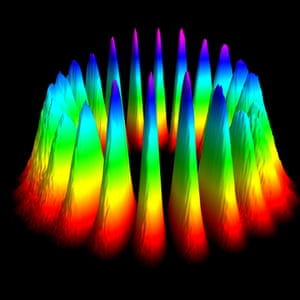
- Innovation category, third prize: Up, up and away by Dr Nina Vyas, University of Birmingham
This underwater bubble, captured with a camera that takes more than 6,000 images per second, has the power to clean surfaces. It rests on the tip of a dental cleaning instrument and starts to dance, in a phenomenon known as cavitation, which happens when ultrasound passes through water. Tiny bubbles grow and collapse, emitting energy used for cleaning. We are finding out how cavitation bubbles could be enhanced to clean teeth and dental implants more effectively and with less pain
Photograph: Dr Nina Vyas/2019 EPSRC Photography Competition
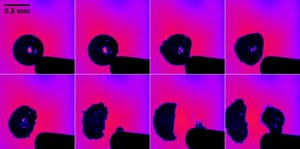
Continue reading...
